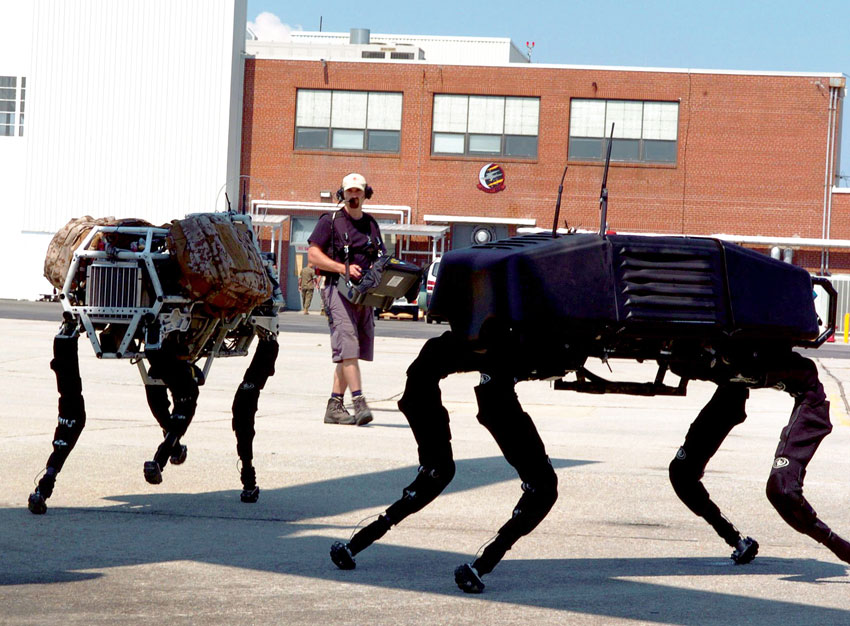
Robohub.org
Robots, soldiers and cyborgs: The future of warfare

When we imagine the future of warfare, we often envision a battlefield where humanoid robots and other machines fight alongside or in the place of human soldiers. From the droids of Star Wars to The Terminator’s cyborg soldiers, robots play a prominent role in our collective vision of future combat.
While science fiction is populated with anthropomorphic and sometimes malevolent robots that can seem remarkably human, in the real world, robots are simply programmable machines that can sense and interact with their environment. From this point of view, most advanced weapons systems are robotic, including cruise missiles, drones, and air and missile defense systems.
Are we at the beginning of an inevitable process leading to the rise of “killer robots” predicted by science fiction, or can robots actually make war less destructive?1 What comes next in the advancement of military robots?
Developing Robotic Weapons
So far, autonomous robots have played a marginal role in warfare. Recently, however, the use of drones to counter the improvised explosive device (IED) threat in Iraq and carry out aerial bombing campaigns in Afghanistan, Pakistan, Yemen, and Somalia has elevated military robots to a more prominent role in U.S. military operations.(a)
As the U.S. winds down its counterinsurgency campaigns in Iraq and Afghanistan, the most important robotic systems used in these conflicts will be far less in demand. These include IED hunters and unmanned aerial vehicles such as Northrop Grumman’s Global Hawk surveillance drones and General Atomics’ armed Predator and Reaper drones. In fact, the Department of Defense plans to slash these drones’ numbers due to both their inability to survive in contested airspaces and general budgetary pressures.
Instead, there will be a greater focus on developing robotic systems for shorter but more massive air campaigns against more sophisticated adversaries with modern air defense systems, like Libya, Syria, China, or Russia. The Pentagon will likely continue its efforts to build global precision strike capability, allowing rapid deployment of unmanned weapons that can attack anywhere in the world within an hour.(b) In addition, there will be a continuing focus on technologies and capabilities relevant for low-intensity conflicts like the ongoing War on Terror.

As for the development of robot soldiers, despite decades of intensive research and continuous breakthroughs in robotics, the progress in creating autonomous military robots has been surprisingly slow. Several projects funded by the Defense Advanced Research Projects Agency (DARPA) have resulted in humanoid robot prototypes, but they lack the portable power source and intelligence that would allow them to act beyond very limited non-combat roles.
The most promising advancements have been the Navy’s X-47 drone, which recently mastered the art of landing on aircraft carriers, and humanoid robot prototypes such as DARPA’s rescue robot Atlas.(c)
The Cyborgization of Human Soldiers
Another approach to implementing robotic weapons systems is to combine them with humans, whose bodies could be augmented with robotic technology. This concept offers the best of both worlds: the quick reaction times, precision, and strength of robotic systems and the control and superior cognitive abilities of humans.
DARPA’s Land Warrior and its successor projects (Objective Force Warrior, Future Force Warrior, and now Warrior Web) aim to equip soldiers with wearable computers, advanced communications gear, helmet visors with night vision and head-up-display, and robotic exoskeletons for improved mobility. While the potential may be vast, such human enhancement has suffered the same setbacks and slow progress as the development of other robotic systems. The gear is still too heavy, and the exoskeletons that could enable soldiers to carry more and move faster lack a sufficient power source.
At the same time, there has been remarkable progress in neuroscience with respect to mapping and manipulating the human brain.2 Though not currently employed, a number of technologies have potential military applications. A technique called transcranial direct current stimulation (tDCS) has been shown to enhance the concentration and alertness of human test subjects.3 EEGs embedded in helmets might one day enable soldiers to control weapons through the power of thought. A research project at Duke University showed that a monkey with an implanted brain chip could control a robotic arm, and researchers at Brown University created the first wireless brain-computer interface in March.(d)
The ultimate goal of some in the Pentagon is to develop “super soldiers” who could be deployed anywhere in the world within hours and remain in the field for extended periods of time. Their bodies and performance could potentially be enhanced through nanosensors that constantly monitor their medical status, embedded nanoneedles that release drugs when needed, and possibly even nanorobots that can quickly heal wounds in the field.(e)
These “super soldiers” might be supported by a range of robotic devices and weapons systems, including robotic dogs to carry their gear, drones to resupply them, and robotic platforms from which to call in long-range precision strikes. The soldiers could one day assign robot helpers specific missions that they could then carry out with little human supervision.(f)
Ethical Concerns And Scientific Unknowns
The use of military robots raises both ethical and tactical concerns. Will they be able to distinguish targets and use force proportionately? Will soldiers be willing to fight alongside completely autonomous robots? Could robots one day entirely replace humans and human-operated systems on the battlefield? What role might robots play in non-traditional wars such as the war on terror or the fight against transnational organized crime? These questions, along with other unknowns, have led United Nations Special Rapporteur Christof Heyns, Human Rights Watch, and other critics to call for a ban on autonomous military robots.4
Critics are also concerned that advanced artificial intelligence (AI) could develop in directions not anticipated by scientists. Because of this unpredictability, the US military has indicated that it will never remove humans from the decision loop completely. While unmanned weapons systems will become gradually more autonomous so that they can carry out very specific missions with less human direction, they may never entirely replace human soldiers on the battlefield.
The technological augmentation and modification of human soldiers raises even more troubling ethical issues than the development of autonomous robots.5 Since millions of dollars could go into technologically upgrading the body and mind of a single soldier, would the soldier be allowed to quit military service? What does it mean for an egalitarian and democratic society to provide certain individuals with superhuman abilities? While enhancing human soldiers may have its benefits, it opens up a web of ethical, political, and legal dilemmas.
What’s Next
Although truly autonomous military robots with strong artificial intelligence could potentially be built and deployed within the next twenty years, there are great doubts about their military usefulness and legality. Fully autonomous robots could easily turn out to be uncontrollable weapons. Furthermore, the difficult budgetary climate will not change in the foreseeable future, which means that the U.S. military has to focus its research and acquisition on the projects relevant to the most likely military needs. Instead of designing robots for war, the Pentagon may aim to enhance and even cyborgize soldiers while further developing human-operated robotic systems. Under the most likely scenarios, it may not be the Pentagon’s robots we should be worried about, but rather the changes in humans that military technology will inaugurate.
ENDNOTES
- Armin Krishnan (2009) Killer Robots: Legality and Ethicality of Autonomous Weapons, Farnham, England: Ashgate.
- The Royal Society (2012) Brain Waves 3: Neuroscience, conflict and security, London: The Royal Society.
- V.P. Clark, B.A. Coffman, A.R. Mayer, M.P. Weisend, T.D. Lane, V.D. Calhoun, E.M. Raybourn, C.M. Garcia, and E.M. Wassermann (2012) “TDCS guided using fMRI significantly accelerates learning to identify concealed objects,”NeuroImage, 59(1): 117-128.
- Christof Heyns (2013) “Report of the Special Rapporteur on extrajudicial, summary or arbitrary executions (A/HRC/23/47),” United Nations General Assembly. Human Rights Watch (2012) Losing Humanity: The Case against Killer Robots.
- Patrick Lin (2012) “More Than Human? The Ethics of Biologically Enhancing Soldiers,” The Atlantic, February 16. Patrick Lin (2013) “Could Human Enhancement Turn Soldiers Into Weapons That Violate International Law? Yes,” The Atlantic, January 4.
If you liked this article, you may also be interested in:
- Robo-Wars: The regulation of robotic weapons
- US DoD report: Preparing for war in the robotic age
- Minesweepers 2014: Outdoor robotic competition on humanitarian demining
- Clearpath’s public stance on Killer Robots sets precedence in corporate responsibility
- America’s dominance in military robotics is starting to crumble
- DARPA’s Gill Pratt on Google’s robotics investments
- Robotics by Invitation: How will robots shape the future of warfare?
- Military robots: No reason to freak out
- The inevitable conflict?
- Active military robots around the world
See all the latest robotics news on Robohub, or sign up for our weekly newsletter.
tags: c-Military-Defense, cx-Politics-Law-Society, cyborg, drones, ethics of technology, exoskeletons, military robotics, Nano






